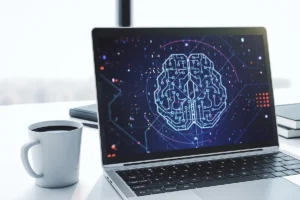Marcos Ríos-Lago highlights the advancements, opportunities, and limitations of technology in the field of neuropsychological assessment, with a critical and integrative perspective.
The omnipresence of technology in our lives
Nowadays, we are surrounded by technology. Just a few days ago, we experienced a blackout that left us without electricity for several hours, allowing us to glimpse the consequences of not having access to the technology we’re used to. Industry, entertainment, transportation, communications, and countless everyday essentials like cooking or having hot water stopped working. Technology surrounds us in virtually every aspect of our lives.
Why has neuropsychology been slow to digitize?
However, some authors have recently pointed out that there are certain disciplines where the use of technology is still symbolic and has not been integrated into everyday work as much as it could be. We are certainly talking about neuropsychology, as noted by Miller and Barr (2017).
Despite its potential advantages and the widespread use of technology in other fields, neuropsychology has yet to make a full transition toward incorporating technological elements that have long been adopted in related areas within the field of rehabilitation.
First steps toward digital transformation in rehabilitation
It’s true that in the field of rehabilitation, the use of computers for cognitive stimulation is more common, and NeuronUP is a good example of that. We’ve also begun conducting remote sessions, which proved to be a great advantage during the pandemic period and allowed treatments to continue for those who couldn’t travel to rehabilitation centers temporarily. This is immediately applicable in rural and underserved areas.
The APA guidelines for telepsychology establish ethical, technical, and psychometric principles for remote neuropsychology via videoconference (American Psychological Association, 2013). In addition, the use of digital tools is already present in electronic health records, given the current needs for information protection.
Neuropsychological assessment: still far from digitalization
However, the use of technology in neuropsychological assessment is still in its early stages, and its implementation is very limited, despite its potential.
Classic tests: the pillars of clinical neuropsychology
At the beginning of the 20th century, interest in understanding the functioning of the human mind and nervous system led to the development of experimental tasks such as what is now known as the Stroop Test (1935), the Trail Making Test (1948), or Rey’s memory tests (1919) and the Rey-Osterrieth Complex Figure (1941) (for a review, see Sherman, Tan, and Hrabok, 2022).
Some time later, these tasks began to be used in clinical settings to characterize the cognitive profile of patients with some type of central nervous system impairment. These tests have become the gold standard in clinical practice.
Why are we still using tests designed 100 years ago?
Almost 100 years later, we are still using these tasks in daily clinical practice. However, over all these years, new tasks have continued to be developed that are allowing us to deepen and expand our knowledge of cognition and the brain, but they haven’t made the leap into the clinical field.
If we have access to the “best” tasks to understand brain functioning and cognitive processes, why don’t we use them in our everyday work with patients?
Advantages of paper-and-pencil tests
Neuropsychologists are well acquainted with the classic paper-and-pencil tests. Today, we know they allow us to assess the performance of mechanisms we now understand (which don’t always align with those for which they were originally designed, based on knowledge from 100 years ago).
Many of them allow us to make reasonably standardized observations to test our cognitive models and, above all, to observe and diagnose behavior in individuals (many of whom experience some form of cognitive impairment for various reasons). In addition, they provide us with solid norms, enabling us to compare an individual’s performance to different reference groups by age, educational level, illness, etc. Of course, we use them every day and can clearly see their advantages (and some of their drawbacks too).
Digitization of neuropsychological assessment: a new era
Today, we have the opportunity to fully introduce digitization into the field of neuropsychological assessment. This digitization of assessment not only responds to the urgency of modernizing century-old protocols but also opens up a range of possibilities that go beyond simply translating classic tests into electronic format.
First stage: protocol conversion
The conversion of classic protocols to electronic formats can constitute the first stage of digitization. In this phase, instructions and administration criteria are replicated, incorporating automatic scoring and new temporal and kinematic metrics (latencies, pauses, tactile pressure, tremor, etc.).
These new measures can help detect micro-variations in stroke order and applied pressure, possibly sensitive indicators of cognitive decline and subtle alterations.
The use of variability or response consistency metrics can also help uncover attentional fluctuations that go unnoticed in classic formats (Harris et al., 2024).
Certainly, this area includes the integration of tasks from basic neuroscience and neuropsychology research that can be useful in clinical settings, thereby reclaiming part of our discipline’s original tradition.
The clinician’s role in the digital age
However, the mere collection of quantitative data lacks interpretive meaning, so a high level of professional knowledge is required. The interpretation of results still largely depends on the clinician’s expertise: scoring norms, the application of heuristics in reasoning, item exclusion criteria, and diagnostic inferences all require a high level of experience.
Still, we must reflect on our own knowledge. For example: ‘Are we experts in traumatic brain injury?’, ‘And how much of an expert are we in a patient who suffered trauma following a failed suicide attempt?’, ‘Are we skilled at managing the consequences of trauma in someone affected by severe depression?’
Perhaps having access to contextual support systems or automated suggestions could enhance our evaluative and therapeutic capabilities.
Second stage: hardware integration
A potential second stage would incorporate additional hardware: accelerometers, haptic sensors, motion sensors, eye-trackers, facial recognition cameras, virtual and augmented reality environments.
Bello et al. (2025) conclude that these technologies remain underused, despite their potential to faithfully recreate instrumental activities of daily living.
With some of these technologies, it might be possible to record frustration responses, anticipatory anxiety, or the ability to detect one’s own errors. All of this currently depends on the clinician’s ability to detect and interpret it appropriately.
Areas such as social cognition, interpersonal conflict resolution, or emotion detection remain largely unexplored territories when it comes to high-resolution quantitative tools. And in a globalized world, the lack of cross-cultural comparisons and versions adapted to different linguistic and educational contexts weakens the ecological validity of many instruments.
Wearables and mobile health in neuropsychology
But returning to the technology that is already in place and surrounds us, we can highlight the so-called wearables, which allow us to record information in real time and in natural environments (Fioerdelli et al., 2013).
Since the launch of the iPhone in 2007, research in mobile health has grown exponentially, with highlights including remote monitoring, frequent data collection in natural settings, health promotion, and longitudinal intra-individual comparisons.
Neuropsychology is not fully utilizing the potential of this data collection in natural environments. This includes recordings of voice, movement, routes, etc. In addition, mobile phones also allow for immediate feedback to the individual, scheduled messaging, optimized alarms and reminders (e.g., geolocated), camera and microphone use, voice recognition, and other functionalities of interest to neuropsychology (Gómez Velez et al., 2017).
Third stage: AI integration
The third and most disruptive stage could be the integration of unified platforms with artificial intelligence (AI). The rapid implementation of various AI tools in recent months and their adoption by the public could accelerate this phase earlier than expected.
The existence of natural language processing systems and their accessibility is accelerating the use of at least some of their functionalities. Nevertheless, it will be useful to further explore this technology.
Diagnostic and intervention capabilities
Supervised and unsupervised learning algorithms can process thousands of variables (kinematics, reaction times, error patterns), analyze complex response patterns, identify atypical cognitive profiles, detect prognostic markers, or suggest neuroanatomical inferences with accuracies that surpass expert judgment in certain specific tasks (Veneziani et al., 2024).
Automated report generation
Moreover, these systems can generate reports that integrate clinical narratives, performance charts, and intervention recommendations (cognitive rehabilitation, pharmacological adjustments) within seconds, significantly reducing decision-making time, the need for treatment changes, and even the time spent on report writing—without reducing (and even increasing) report quality.
Normative databases and diagnostic personalization
A key aspect for the proper functioning of these tools is the construction of large multicenter normative databases, with cross-cultural validation and data that allow for adjustments based on different parameters (age, education level, comorbidities, etc.), enabling personalized diagnoses and cut-off points.
Ethical considerations and regulatory challenges in the digitization of neuropsychology
However, the transition to this Neuropsychology 3.0 entails regulatory and ethical challenges (Bilder, 2011; Harris et al., 2024).
The GDPR requires encryption, anonymization, and traceability in the management of sensitive data. Furthermore, approval of AI-based tools by agencies such as the EMA or FDA is still in its early stages.
Still, beyond this, there is a fundamental element that does not lie with these institutions or the corresponding legislator, but with those of us who create, teach, and use this technology: continuous learning, proper use, and understanding of its limits and capabilities.
Only with responsible and appropriate use can these technologies make us better. We cannot delegate our tasks and responsibilities to language models, but we can use them as tools to enhance our capabilities and closely supervise the results they provide. This demands continuous learning, in addition to the one we are already committed to as neuropsychology professionals.
Conclusion: toward a more accurate, ecological, and personalized neuropsychology
The core message seems clear to me: to overcome the inertia of the past and meet the clinical demands of the 21st century, it is necessary to embrace intelligent digitization that respects psychometric rigor, enhances diagnostic sensitivity, and paves the way toward truly ecological and personalized assessments.
This way, neuropsychology will be able to faithfully evaluate complex human behavior and offer precision interventions that improve the quality of life for those suffering from cognitive impairments.
None of this, moreover, is incompatible with careful and close observation of the people who come to us for evaluations and treatments. We are facing an important challenge where we must integrate the past with the future (which is actually the present). This train has already left the station. It’s up to us to get on and lead it—or wait for others to do it for us.
References
- American Psychological Association. (2013, July). Guidelines for the Practice of Telepsychology. https://www.apa.org/about/policy/telepsychology-revisions
- Bello, K., Aqlan, F., & Harrington, W. (2025). Extended reality for neurocognitive assessment: A systematic review. Journal of Psychiatric Research, 184, 473–487. https://doi.org/10.1016/j.jpsychires.2025.03.034
- Bilder RM. (2011). Neuropsychology 3.0: Evidence-Based Science and Practice. Journal of the International Neuropsychological Society: JINS, 17(1), 7–13. https://doi.org/10.1017/S1355617710001396
- Harris C, Tang Y, Birnbaum E, Cherian C, Mendhe D, Chen MH. (2024). Digital Neuropsychology Beyond Computerized Cognitive Assessment: Applications of Novel Digital Technologies, Archives of Clinical Neuropsychology, 39(3), 290–304. https://doi.org/10.1093/arclin/acae016
- Gómez A, Nieto López S, González Rey N, and Ríos Lago M. (2017). The Use of Mobile Phones in the Rehabilitation of Brain Injuries. Informaciones Psiquiátricas. 229. 53–77
- Miller JB and Barr WB. (2017). The Technology Crisis in Neuropsychology. Archives of Clinical Neuropsychology, 32(5), 541–554. https://doi.org/10.1093/arclin/acx050
- Sherman EMS, Tan JE, and Hrabok M. (2022). A Compendium of Neuropsychological Tests: Fundamentals of Neuropsychological Assessment and Test Reviews for Clinical Practice (4th Ed). Oxford University Press
- Veneziani, I., Marra, A., Formica, C., Grimaldi, A., Marino, S., Quartarone, A., & Maresca, G. (2024). Applications of Artificial Intelligence in the Neuropsychological Assessment of Dementia: A Systematic Review. Journal of Personalized Medicine, 14(1), 113. https://doi.org/10.3390/jpm14010113





Leave a Reply